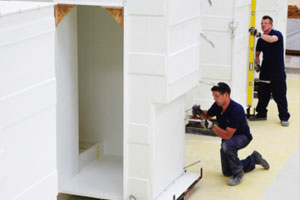Richard Tonkinson, executive director of bathroom pod manufacturer Offsite Solutions, offers some practical advice for specifying factory-built bathrooms...
The shift towards offsite across the construction industry is being driven by the shortage of skilled labour (which is compounded by Brexit), issues with consistent quality and the construction industry’s poor record of on time and on budget delivery. The publication of reports such as the recent House of Lords committee review into offsite manufacture has further highlighted the need to move more work offsite. Reducing the number of activities and trades on site results in significant programme savings, quality improvements and waste reductions of up to 50%.
TYPES OF BATHROOM PODS
The most common factory-built bathrooms are:
• Steel-framed pods – for ceramic-tiled finishes and a high level of design flexibility. • GRP pods – lower capital expenditure and easy to maintain and clean. Widely used for affordable housing schemes.
• Hybrid GRP pods – an enhanced finish and improved aesthetics for GRP pods, such as ceramic tiling, back-painted glass panels and recesses.
• Floorless pods – for projects where a continuous level floor finish is required throughout a building or for schemes requiring bathroom floors with no threshold and where a slab recess is not feasible.
HOW ARE PODS INSTALLED?
Factory-built bathrooms are delivered on a supply only basis and the main contractor organises installation via the M&E contractor. Ten GRP pods can be delivered to site in two hours – or 6-8 steel-framed pods. It can take around 80 hours for an in- situ bathroom to be built on site, requiring around seven different trades and 10-15 operations plus drying times.
A pod can be manufactured in 14 hours with just one supplier, which means improved quality, reduced defects and remedial works.
KEY SPECIFICATION CONSIDERATIONS
1. Early engagement – essential to achieve optimal efficiency by designing pods into the early stages of a construction project.
2. Consider access – accommodate pod installation in the build-up of walls and floors and take account of access for delivery, particularly on constrained sites.
3. Look at economies of scale – standardised designs with minimal variations allow cost savings and time efficiencies by using the repetition of the production process. A good manufacturer will have an extensive library of pod designs.
4. Integrating pods with building services - Connections to services are made externally so access should be allowed as part of the installation process. A good manufacturer will design the pods to facilitate installation and reduce work on site.
5. Pod installation- The floor slab should be flat and level to +/- 10mm tolerance for accurate installation.
Ensure the perimeter base frame is correctly sized to have the structural rigidity to transport and lift the pod and to minimise any flexing of the floor or floor damage could result. Each frame and pod type should be tested for safe and level lifting. A method statement and test certificates should provided in accordance with CDM regulations.
6. How to ensure longevity
• Steel-framed pods: They should have a double skin with timber and plasterboard in cementitious board construction to Lifetime Homes standards. This will facilitate tile replacement. The entire walls and floor to the wet area should be fully tanked – not just half of the shower wall. All exposed external plasterboard edge joints should also be tanked.
• GRP pods: Need robust wall detailing with encapsulated honeycomb polypropylene. Be aware that cheaper alternatives such as cardboard can be susceptible to delamination.
A panelised system should be used to create vertical walls and 90° corners. This avoids tapered walls for improved aesthetics and to allow easier integration and the use of standard door sets without further work on site.
7. Check factory testing
Stringent air and water tests should be carried out in the factory. We recommend every 5th pod undergoes a comprehensive functionality test.
The completed electrical installation should undergo a full function and resistance test carried out by independent NICEIC-approved electricians.
Test certificates should be provided for electrics and plumbing. This should be added to your specification.
See offsitesolutions.com/CPD for courses available.

Add new comment